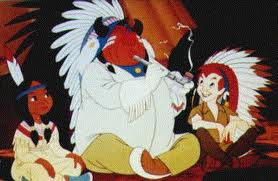Today we move on from Pinocchio. My thought was to go through the Disney cannon in chronological order, if only so that I can remember what I have and haven't talked about, but then I realized that I skipped Snow White and the Seven Dwarfs. I watched the film yesterday and I didn't really see anything that makes waves. Perhaps this is because it was Disney's first feature film, or perhaps it means that the company and Walt himself did not ever intend to present offensive material. If you think that there is anything racist worth talking about let me know in the comments and I can return to this topic.
Lets move on to the net film, Fantasia! Cards on the table, despite many attempts I have never seen the entirety of Fantasia in one sitting. Partly because I usually get interrupted by something and have to pause and come back later and partly because I tend to fall asleep. That being said, I do really like this film and I can appreciate it for what it brought to the entertainment world, an early version of surround sound in theatres. There are a few things throughout this film that are worth mentioning so Fantasia, like Pinocchio, will likely warrant a few days of discussion and analysis. For each segment worth discussing under the umbrella topic of racism I will devote one post, this will keep things from getting to long.
I was listening to a podcast a while back and I can't remember which one it was, but they were discussing Fantasia and they were talking about how amazing it would have been to see Fantasia when it first came out. they suggested that we loose a lot of the allure of the film watching it at home. I tend to agree. However, one point was made that I must disagree with. They suggested that it would have been amazing to have the film play with a live orchestra.
For us today, that would be really cool. But for theatres of this time it would have been seen as a step backwards. Silent films in theatres often had a piano or orchestra playing alongside them. Once sound was added to film the speaker was projected from behind the screen. What Disney came up with was revolutionary, it was early surround sound. It enabled everyday people to hear the full bodies sound of attending an orchestral performance without the high cost. People would have been amazed to hear the, then incredible, sound quality of the surround sound. That first time experience is a part of the film that has been lost throughout the ages and the development of technology. It is something that we can never recreate and it keeps us from fully seeing Fantasia in the light that it was originally meant to be seen.
Tomorrow we actually delve into the racism of Fantasia, and I promise that the following images have a lot to do with it.

























